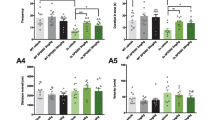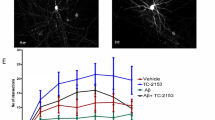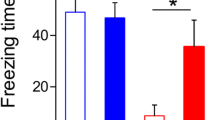Abstract
Alzheimer’s disease is a progressive neurodegenerative disorder characterized by impairments in synaptic plasticity and cognitive performance. Current treatments are unable to achieve satisfactory therapeutic effects or reverse the progression of the disease. Calcineurin has been implicated as part of a critical signaling pathway for learning and memory, and neuronal calcineurin may be hyperactivated in AD. To investigate the effects and underlying mechanisms of FK506, a calcineurin inhibitor, on Alzheimer-like behavior and synaptic dysfunction in the 3 × Tg-AD transgenic mouse model of Alzheimer’s disease, we investigated the effect of FK506 on cognitive function and synaptic plasticity in the 3 × Tg-AD transgenic mouse model of Alzheimer’s disease. The results showed that FK506 treatment ameliorated cognitive deficits, as indicated by the decreased latency in the water maze, and attenuated tau hyperphosphorylation in 3 × Tg-AD mice. Treatment with FK506 also reduced the levels of certain markers of postsynaptic deficits, including PSD-95 and NR2B, and reversed the long-term potentiation deficiency and dendritic spine impairments in 3 × Tg-AD mice. These findings suggest that treatment with calcineurin inhibitors such as FK506 can be an effective therapeutic strategy to rescue synaptic deficit and cognitive impairment in familial Alzheimer’s disease and related tauopathies.




Similar content being viewed by others
Data availability
The authors declare that the data supporting the findings of this study are available within the article and its additional files, or from the authors upon request.
References
Al-Onaizi M, Al-Sarraf A, Braysh K, Kazem F, Hetal A-H (2022) Impaired spatial navigation and age-dependent hippocampal synaptic dysfunction are associated with chronic inflammatory response in db/db mice. Eur J Neurosci 56(11):6003–6021. https://doi.org/10.1111/ejn.15835
Amit K, Nirmal S (2017) Calcineurin inhibitors improve memory loss and neuropathological changes in mouse model of dementia. Pharmacol Biochem Behav 153:147–159. https://doi.org/10.1016/j.pbb.2016.12.018
Chen QS, Wei WZ, Shimahara T, Xie CW (2002) Alzheimer amyloid beta-peptide inhibits the late phase of long-term potentiation through calcineurin-dependent mechanisms in the hippocampal dentate gyrus. Neurobiol Learn Mem 77(3):354–371. https://doi.org/10.1006/nlme.2001.4034
Cummings J, Aisen P, Apostolova LG, Atri A, Setal S (2021) Aducanumab: appropriate use recommendations. The Journal of Prevention of Alzheimer’s Disease 8(4):398–410. https://doi.org/10.14283/jpad.2021.41
Demuro A, Mina E, Kayed R, Milton SC, Ietal P (2005) Calcium dysregulation and membrane disruption as a ubiquitous neurotoxic mechanism of soluble amyloid oligomers. J Biol Chem 280(17):17294–17300. https://doi.org/10.1074/jbc.M500997200
Dineley KT, Hogan D, Zhang WR, Taglialatela G (2007) Acute inhibition of calcineurin restores associative learning and memory in Tg2576 APP transgenic mice. Neurobiol Learn Mem 88(2):217–224. https://doi.org/10.1016/j.nlm.2007.03.010
Dineley KT, Kayed R, Neugebauer V, Fu Y, Zhang W et al (2010) Amyloid-beta oligomers impair fear conditioned memory in a calcineurin-dependent fashion in mice. J Neurosci Res 88(13):2923–2932. https://doi.org/10.1002/jnr.22445
Gaugler J, James BT, Reimer J, Solis M, Jetal W (2022) Alzheimer’s disease facts and figures. Alzheimers Dementia 18(4):700–789. https://doi.org/10.1002/alz.12638
Guedes-Dias P, Holzbaur ELF (2019) Axonal transport: driving synaptic function. Science 366(6462):eaaw 9997. https://doi.org/10.1126/science.aaw9997
Jung JA, Yoon YJ (2020) Development of non-immunosuppressive FK506 derivatives as antifungal and neurotrophic agents. J Microbiol Biotechnol 30(1):1–10. https://doi.org/10.4014/jmb.1911.11008
Juvvadi PR, Bobay BG, Gobeil SMC, Cole DC, Venters RA et al (2020) FKBP12 dimerization mutations effect FK506 binding and differentially alter calcineurin inhibition in the human pathogen aspergillus fumigatus. Biochem Biophys Res Commun 526(1):48–54. https://doi.org/10.1016/j.bbrc.2020.03.062
Karch CM, Jeng AT, Goate AM (2013) Calcium phosphatase calcineurin influences tau metabolism. Neurobiol Aging 34(2):374–386. https://doi.org/10.1016/j.neurobiolaging.2012.05.003
Liu B, Kou J, Li F, Huo D, Xu J et al (2020) Lemon essential oil ameliorates age-associated cognitive dysfunction via modulating hippocampal synaptic density and inhibiting acetylcholinesterase. Aging (albany NY) 12(9):8622–8639. https://doi.org/10.18632/aging.103179
Liu J, Si Z, Li S, Huang Z, He Y et al (2018) The calcineurin inhibitor FK506 prevents cognitive impairment by inhibiting reactive astrogliosis in pilocarpine-induced status epilepticus rats. Front Cell Neurosci 11:428. https://doi.org/10.3389/fncel.2017.00428
Luo J, Ma J, Da-Yu Y, Fan B, Zhang W et al (2008) Infusion of FK506, a specific inhibitor of calcineurin, induces potent tau hyperphosphorylation in mouse brain. Brain Res Bull 76(5):464–468. https://doi.org/10.1016/j.brainresbull.2007.12.00
McLeod F, Boyle K, Marzo A, Martin-Flores N, Moe TZ et al (2020) Wnt signaling through nitric oxide synthase promotes the formation of multi-innervated Spines. Front Synaptic Neurosci 12:575863. https://doi.org/10.3389/fnsyn.2020.575863
Miller EC, Teravskis PJ, Dummer BW, Zhao X, Huganir RL et al (2014) Tau phosphorylation and tau mislocalization mediate soluble Aβ oligomer-induced AMPA glutamate receptor signaling deficits. Eur J Neurosci 39(7):1214–1224. https://doi.org/10.1111/ejn.12507
Norris CM, Kadish I, Blalock EM, Chen KC, Thibault V et al (2005) Calcineurin triggers reactive/inflammatory processes in astrocytes and is upregulated in aging and alzheimer’s models. J Neurosci 25(8):4649–4658. https://doi.org/10.1523/JNEUROSCI.0365-05.2005
Parlakpinar H, Gunata M (2021) Transplantation and immunosuppression: a review of novel transplant-related immunosuppressant drugs. Immunopharmacol Immunotoxicol 43(6):651–665. https://doi.org/10.1080/08923973.2021.1966033
Radhakrishnan H, Ubele MF, Krumholz SM, Boaz K, Mefford JL et al (2021) Tacrolimus protects against age-associated microstructural changes in the beagle brain. J Neurosci 41(23):5124–5133. https://doi.org/10.1523/JNEUROSCI.0361-21.2021
Rajput MS, Nirmal NP, Rathore D, Dahima R (2020) Dimethyl fumarate exerts neuroprotection by modulating calcineurin/NFAT1 and NFκB dependent BACE1 activity in Aβ1-42 treated neuroblastoma SH-SY5Y cells. Brain Res Bull 165:97–107. https://doi.org/10.1016/j.brainresbull.2020.08.024
Rozkalne A, Hyman BT, Spires-Jones TL (2011) Calcineurin inhibition with FK506 ameliorates dendritic spine density deficits in plaque-bearing alzheimer model mice. Neurobiol Dis 41(3):650–654. https://doi.org/10.1016/j.nbd.2010.11.014
Saraf J, Bhattacharya P, Kalia K, Borah A, Sarmah D et al (2018) A friend or foe: calcineurin across the gamut of neurological disorders. ACS Cent Sci 4(7):805–819. https://doi.org/10.1021/acscentsci.8b00230
Scheltens P, De Strooper B, Kivipelto M, Holstege H, Chételat G et al (2021) Alzheimer’s disease. Lancet 397(10284):1577–1590. https://doi.org/10.1016/S0140-6736(20)32205-4
Shankar GM, Bloodgood BL, Townsend M, Walsh DM, Selkoe DJ et al (2007) Natural oligomers of the alzheimer amyloid-beta protein induce reversible synapse loss by modulating an NMDA-type glutamate receptor-dependent signaling pathway. J Neurosci 27(11):2866–2875. https://doi.org/10.1523/JNEUROSCI.4970-06.2007
Stallings NR, O’Neal MA, Hu J, Kavalali ET, Bezprozvanny I et al (2018) Pin1 mediates A beta (42)-induced dendritic spine loss. Sci Signal 11(522):eaap8734. https://doi.org/10.1126/scisignal.aap8734
Stroebel D, Mony L, Paoletti P (2021) Glycine agonism in ionotropic glutamate receptors. Neuropharmacology 193:108631. https://doi.org/10.1016/j.neuropharm.2021.108631
Taglialatela G, Hogan D, Zhang WR, Dineley KT (2009) Intermediate and long-term recognition memory deficits in Tg2576 mice are reversed with acute calcineurin inhibition. Behav Brain Res 200(1):95–99. https://doi.org/10.1016/j.bbr.2008.12.034
Taglialatela G, Rastellini C, Cicalese L (2015) Reduced incidence of dementia in solid organ transplant patients treated with calcineurin inhibitors. J Alzheimers Dis 47(2):329–333. https://doi.org/10.3233/JAD-150065
Tucker ES, Ibrahim R, Kakodkar R, Kreiling JA, Creton R (2021) A zebrafish model for calcineurin-dependent brain function. Behav Brain Res 416:113544. https://doi.org/10.1016/j.bbr.2021.113544
Umar T, Meena R, Mustehasan KP, Khan AA (2022) Recent updates in the development of small molecules as potential clinical candidates for alzheimer’s disease: a review. Chem Biol Drug Des 100(5):674–681. https://doi.org/10.1111/cbdd.14133
Wang T, Bai Y, Zheng X, Liu X, Xing S et al (2023) Sapap4 deficiency leads to postsynaptic defects and abnormal behaviors relevant to hyperkinetic neuropsychiatric disorder in mice. Cereb Cortex 33(4):1104–1118. https://doi.org/10.1093/cercor/bhac123
Wong LW, Wang Z, Ang SRX, Sajikumar S (2022) Fading memories in aging and neurodegeneration: is p75 neurotrophin receptor a culprit? Ageing Res Rev 75:101567. https://doi.org/10.1016/j.arr.2022.101567
Wu HY, Hudry E, Hashimoto T, Kuchibhotla K, Rozkalne A et al (2010) Amyloid beta induces the morphological neurodegenerative triad of spine loss, dendritic simplification, and neuritic dystrophies through calcineurin activation. J Neurosci 30(7):2636–2649. https://doi.org/10.1523/JNEUROSCI.4456-09.2010
Yan W, Guo T, Liu N, Cui X, Wei X et al (2023) Erythropoietin ameliorates cognitive deficits by improving hippocampal and synaptic damage in streptozotocin-induced diabetic mice. Cell Signal 106:110614. https://doi.org/10.1016/j.cellsig.2023.110614
Yu TW, Lane HY, Lin CH (2021) Novel therapeutic approaches for alzheimer’s disease: an updated review. Int J Mol Sci 22(15):8208. https://doi.org/10.3390/ijms22158208
Zhang H, Liu J, Sun S, Pchitskaya E, Popugaeva E et al (2015) Calcium signaling, excitability, and synaptic plasticity defects in a mouse model of alzheimer’s disease. J Alzheimers Dis 45(2):561–580. https://doi.org/10.3233/JAD-142427
Zhao WQ, Santini F, Breese R, Ross D, Zhang XD et al (2010) Inhibition of calcineurin-mediated endocytosis and alphaamino-3-hydroxy-5-methyl-4-isoxazolepropionic acid (AMPA) receptors prevents amyloid beta oligomer-induced synaptic disruption. J Biol Chem 285(10):7619–7632. https://doi.org/10.1074/jbc.M109.057182
Acknowledgements
This work was supported by The Foundation of Hubei Science & Technology Department (2022CFB974) to Dong-Sheng Sun.
Author information
Authors and Affiliations
Contributions
This study was initiated and designed by QF; QF directed and coordinated the study; JZ and XFH performed major animal behavior studies, Western blotting, and immunohistochemistry; DSS and JZM performed brain slice electrophysiology recordings, brain Golgi staining, dendritic morphology analysis, and collected and analyzed the data; XYH helped to collect and analyze the data; JZM performed immunohistochemistry, helped to interpret the results, and commented on the manuscript; and QF and JZ wrote the manuscript. All authors read and approved the final manuscript.
Corresponding author
Ethics declarations
Conflict of interest
On behalf of all authors, the corresponding author states that there is no financial or non-financial confict of interest.
Additional information
Communicated by Sreedharan Sajikumar.
Publisher's Note
Springer Nature remains neutral with regard to jurisdictional claims in published maps and institutional affiliations.
Rights and permissions
Springer Nature or its licensor (e.g. a society or other partner) holds exclusive rights to this article under a publishing agreement with the author(s) or other rightsholder(s); author self-archiving of the accepted manuscript version of this article is solely governed by the terms of such publishing agreement and applicable law.
About this article
Cite this article
Zeng, J., Hu, XF., Sun, DS. et al. Alzheimer-like behavior and synaptic dysfunction in 3 × Tg-AD mice are reversed with calcineurin inhibition. Exp Brain Res 242, 1507–1515 (2024). https://doi.org/10.1007/s00221-024-06841-8
Received:
Accepted:
Published:
Issue Date:
DOI: https://doi.org/10.1007/s00221-024-06841-8




